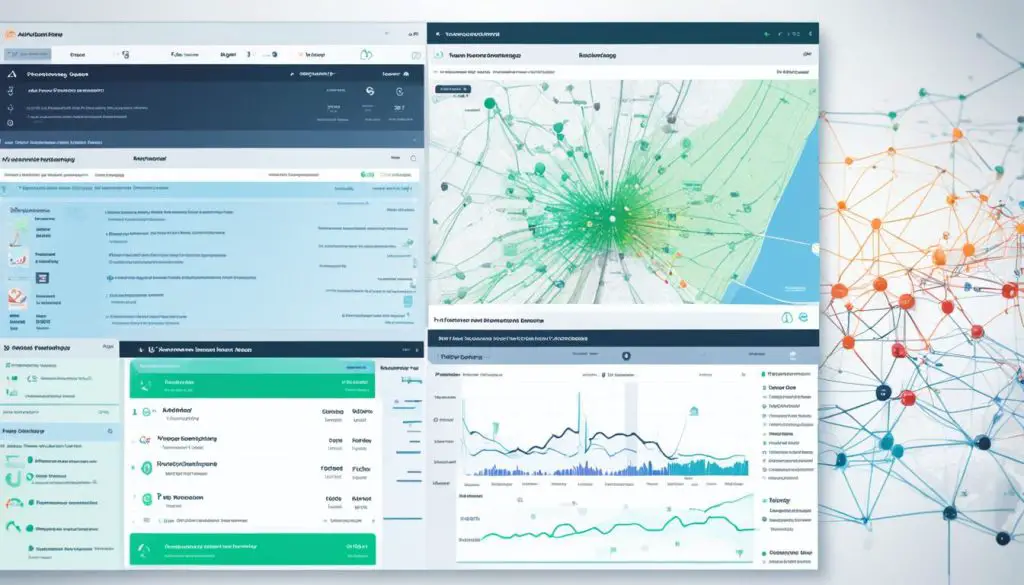LibreNMS vs. Observium: Best Network Monitoring Solution?
When it comes to network monitoring tools, the options can be overwhelming. Which one is the best for your organization? In this article, I will delve into the comparison of two popular network monitoring solutions: LibreNMS and Observium. Brace yourself, because what you thought you knew about network monitoring may be challenged.
Key Takeaways:
- Observium and LibreNMS are two leading network monitoring tools in the industry.
- Observium focuses on real-time performance monitoring, while LibreNMS emphasizes system performance and alerting.
- The choice between Observium and LibreNMS depends on factors such as organization size, technical expertise, and customization requirements.
- Observium offers a wide range of features and has an established user base, while LibreNMS is open-source and user-friendly.
- Ultimately, the best network monitoring solution for your organization is the one that aligns with your specific needs and preferences.
Understanding Observium and LibreNMS
In the world of network monitoring tools, Observium and LibreNMS stand out as popular choices. While both offer valuable features for monitoring network devices, they have their own unique characteristics that set them apart.
Observium:
Observium is a full-featured network monitoring and management system that automates tasks in network administration. It provides a comprehensive set of tools for monitoring and managing network devices, making it a valuable asset for IT professionals.
LibreNMS:
On the other hand, LibreNMS is an open-source network monitoring system that offers a range of monitoring tools for network devices. It is particularly known for its user-friendly interface and ease of use, making it an attractive choice for organizations.
One key difference between Observium and LibreNMS lies in the data collection methods they employ. Observium predominantly utilizes SNMP (Simple Network Management Protocol) to collect data from network devices. In contrast, LibreNMS utilizes multiple protocols such as SNMP, WMI (Windows Management Instrumentation), and SSH (Secure Shell), enabling it to gather more detailed information from a wider range of devices.
By leveraging different protocols, LibreNMS can provide a more granular level of monitoring and facilitate in-depth analysis of network performance. This can be particularly beneficial for organizations that require detailed insights into their network infrastructure.
With a better understanding of Observium and LibreNMS, let’s explore the key differences between these two network monitoring tools in the next section.
Key Differences between Observium and LibreNMS
When comparing Observium and LibreNMS, it’s important to understand their key differences. These differences can help you determine which network monitoring solution better suits your needs.
Data Collection Approach
One of the main differences between Observium and LibreNMS lies in their approach to data collection. Observium primarily relies on SNMP (Simple Network Management Protocol) for data collection. On the other hand, LibreNMS goes beyond SNMP and utilizes multiple protocols, including SNMP, WMI (Windows Management Instrumentation), and SSH (Secure Shell). This broader range of protocols allows LibreNMS to gather more detailed information from a wider variety of network devices.
Focus and Emphasis
Observium’s primary focus is on real-time performance monitoring, device discovery, alerting, and graphing. It provides comprehensive real-time insights into network performance and allows for proactive response to any changes or issues. On the other hand, LibreNMS places greater emphasis on device discovery, system performance, and alerting. It provides a holistic view of the network environment, allowing for effective management and response to network events.
With Observium’s real-time focus, it excels in delivering up-to-the-minute information and immediate notifications that enable rapid troubleshooting and maintenance. Conversely, LibreNMS shines with its comprehensive device discovery and system performance monitoring, providing valuable insights into the overall health and performance of the network.
In Summary
Observium and LibreNMS differ in their data collection approach, with Observium relying primarily on SNMP and LibreNMS utilizing multiple protocols like SNMP, WMI, and SSH. Additionally, Observium prioritizes real-time performance monitoring, device discovery, alerting, and graphing, while LibreNMS places greater emphasis on device discovery, system performance, and alerting. Understanding these key differences will help you make an informed decision when choosing the right network monitoring tool for your organization.
Evaluating Features and Capabilities
When comparing Observium and LibreNMS, it’s essential to evaluate their features and capabilities to determine which network monitoring tool best suits your needs. Let’s take a closer look at the key features offered by each:
Observium Features
Observium boasts extensive support for a wide range of devices and operating systems, making it a versatile choice for network performance monitoring. It includes support for popular brands like Cisco, Juniper, and Dell, ensuring compatibility across various network infrastructures.
One of the standout features of Observium is its robust performance monitoring metrics. It provides comprehensive insights into key performance indicators, allowing you to proactively identify and address potential issues before they impact your network’s performance.
Additionally, Observium offers powerful graphing tools, visually presenting performance data in a user-friendly and easily interpretable format. This enables efficient analysis and troubleshooting, empowering network administrators to make informed decisions to optimize network performance.
LibreNMS Features
Similar to Observium, LibreNMS supports a broad array of network devices, ensuring compatibility in diverse network environments. It provides an intuitive web-based interface, simplifying device configuration and management, making it accessible for users of varying technical expertise.
LibreNMS emphasizes simplicity and ease of use, making it an attractive option for organizations looking for a straightforward network monitoring tool. It offers features such as automatic device discovery and network mapping, simplifying the process of identifying and managing network devices.
While Observium primarily focuses on performance monitoring, LibreNMS places equal emphasis on system performance, providing an all-encompassing view of your network’s health. This extensive monitoring capability ensures that you have detailed insights into the overall performance of your network and its individual components.
Summary
Observium and LibreNMS are both powerful network monitoring tools, each with its unique set of features and capabilities. Observium stands out with its broad device support, comprehensive performance monitoring metrics, and advanced graphing tools. On the other hand, LibreNMS offers an intuitive interface, automatic device discovery, and holistic system performance monitoring.
Ultimately, the choice between Observium and LibreNMS depends on your specific requirements, network infrastructure, and preference for simplicity or advanced performance monitoring. By carefully evaluating their features and capabilities, you can select the network monitoring tool that aligns best with your organization’s needs.
Considering Pricing and Support
When it comes to choosing a network monitoring tool, pricing and support are important factors to consider. Both Observium and LibreNMS offer unique pricing models and levels of support that cater to different needs. Let’s take a closer look.
Observium Pricing
Observium provides both free and paid versions, allowing users to choose the option that best suits their requirements. The free version offers a range of essential features and can be a good starting point for small organizations or those on a tight budget. However, if you require additional advanced features or dedicated support, the paid version of Observium is available at a reasonable cost.
LibreNMS Pricing
Unlike Observium, LibreNMS is completely open-source and free to use. This makes it an attractive option for organizations looking to minimize costs. However, it’s worth noting that the installation and maintenance of LibreNMS may require more technical expertise compared to Observium. While there is no direct cost associated with LibreNMS, it’s important to consider the potential investment of time and resources required to set it up and keep it running smoothly.
Network Monitoring Tools Support
When it comes to community support and user base, Observium has a significant advantage. Due to its established presence in the industry, Observium has a larger user community that actively contributes to its development and provides valuable support. This can be beneficial when seeking assistance or troubleshooting any issues you may encounter.
On the other hand, LibreNMS is gaining popularity and has a growing community of users who actively contribute to its development. While the community support for LibreNMS may not be as extensive as that of Observium, it continues to expand and provide valuable resources and assistance for users.
Ultimately, the choice between Observium and LibreNMS in terms of pricing and support depends on your specific requirements, budget, and level of technical expertise. Observium offers a paid version with additional features and dedicated support, while LibreNMS provides an open-source solution for organizations with the necessary technical capabilities.
Advantages and Disadvantages of Observium and LibreNMS
When comparing Observium and LibreNMS, it is important to consider their unique advantages and disadvantages. Both network monitoring tools have their strengths and weaknesses, and understanding them will help you make an informed decision.
Observium Pros:
- Wide range of capabilities: Observium offers a comprehensive set of features, including real-time performance monitoring, device discovery, alerting, and robust performance graphing. Its extensive capabilities make it a versatile tool for network monitoring.
- Customizable monitoring strategies: Observium allows for flexible monitoring configurations, enabling users to tailor their monitoring approach to meet their specific needs. This customization feature adds to the tool’s versatility and adaptability.
- Robust performance graphing: Observium provides detailed performance graphing, allowing users to visualize network data and performance trends effectively. This feature enables efficient troubleshooting and performance analysis.
Observium Cons:
- Paid platform: Observium offers a free version, but its full range of capabilities is available in the paid version, which may not be suitable for organizations with budget constraints.
- Requires technical expertise: Implementing and configuring Observium may require a certain level of technical expertise, especially when setting up more complex monitoring configurations and integrations.
LibreNMS Pros:
- Easy to set up: LibreNMS is known for its simplified installation process, making it accessible to users with varying levels of technical knowledge. This ease of setup allows for a quick start to network monitoring activities.
- User-friendly interface: LibreNMS provides an intuitive and user-friendly web-based interface, enabling users to navigate and configure the tool with ease. The interface simplifies device management and monitoring tasks.
- Free to use: LibreNMS is an open-source tool, which means there are no licensing fees involved. This makes it a cost-effective choice for organizations looking for a budget-friendly solution.
LibreNMS Cons:
- Limited customization options: Compared to Observium, LibreNMS may have fewer customization options, making it less suitable for organizations with specific or advanced monitoring requirements.
- Limited community support: While LibreNMS has an active community contributing to its development, it may have fewer resources and community support compared to Observium. This could impact the availability of documentation and assistance.
Considering these pros and cons will help you evaluate Observium and LibreNMS based on your organization’s specific needs, budget, and technical expertise. While Observium offers a wide range of capabilities and robust performance graphing, it is a paid platform that requires technical know-how. On the other hand, LibreNMS is easy to set up, has a user-friendly interface, and is free to use, although it may have limited customization options and community support.
Choosing the Right Network Monitoring Tool
When deciding on a network monitoring tool for your organization, it’s important to consider various factors that can impact its effectiveness. Two popular options in the market are Observium and LibreNMS.
Observium is suitable for smaller organizations with limited resources, while LibreNMS offers scalability and customization, making it a better choice for larger organizations.
The size of your organization plays a crucial role in determining which tool is most appropriate for your needs. Observium, with its comprehensive features and ease of use, is an excellent choice for smaller companies that require network monitoring on a smaller scale. Its affordability and straightforward implementation make it accessible to organizations with limited budgets and technical expertise.
In contrast, larger organizations benefit from the scalability and customization provided by LibreNMS. Its robust capabilities and compatibility with a wide range of devices make it ideal for monitoring complex networks. With LibreNMS, you can easily tailor the tool to meet your specific requirements and have greater control over your network monitoring processes.
Another important consideration is your level of technical expertise. While both Observium and LibreNMS offer user-friendly interfaces, Observium requires less technical knowledge for setup and maintenance. Its intuitive design allows for quick and seamless implementation, providing immediate monitoring capabilities. On the other hand, LibreNMS, although more customizable, may involve a steeper learning curve for users without prior experience or technical skills.
Your organization’s budget is also a critical factor in the decision-making process. Observium offers both free and paid versions, which allow you to choose the features and support that align with your financial capabilities. LibreNMS, being an open-source tool, is free to use, but may require additional resources for customization and maintenance.
In conclusion, when choosing a network monitoring tool, consider the size of your organization, your level of technical expertise, your budget, and your desired level of customization. Observium is well-suited for smaller organizations with limited resources, providing comprehensive features at an affordable price. On the other hand, LibreNMS offers scalability, customization, and compatibility with a wide range of devices, making it the preferred choice for larger organizations seeking greater control over their network monitoring processes.

Setting Up and Configuring Observium and LibreNMS
Setting up Observium and LibreNMS requires a few steps to ensure proper installation and configuration. Let’s go through the process for each network monitoring tool.
Setting up Observium
- Download and install Observium on your server. Make sure your server meets the system requirements specified by Observium.
- Configure SNMP (Simple Network Management Protocol) on the devices you want to monitor. This will allow Observium to collect data from these devices.
- Set up other monitoring protocols supported by Observium if needed. These protocols can include SNMPv3, WMI, and SSH, depending on your network infrastructure.
- Configure performance graphing and alerting features in Observium. This will enable you to visualize the collected data and receive alerts when specific thresholds are reached.
Once you have completed these steps, Observium will be set up and ready to monitor your network devices.
Setting up LibreNMS
- Download and install LibreNMS on your server according to the installation instructions provided by the project.
- Assign the necessary configuration details in LibreNMS, such as database credentials and network device details. These details will be used by LibreNMS to collect data from your network devices.
- Configure alerting and notification features in LibreNMS. This will allow you to receive alerts and notifications when specific events occur in your network.
After completing these steps, you will have successfully set up LibreNMS and can begin monitoring your network devices.
Conclusion
In conclusion, Observium and LibreNMS are two powerful network monitoring solutions that offer unique features and benefits. When choosing between the two, it is important to consider the specific needs of your organization.
Observium, with its established user base and wide range of features, is a reliable choice for organizations of all sizes. It provides comprehensive performance monitoring metrics, device discovery, alerting, and graphing capabilities. However, it is important to note that Observium is a paid platform and may require technical expertise for setup and maintenance.
On the other hand, LibreNMS is an open-source and user-friendly network monitoring solution. It supports a similar range of network devices and offers an intuitive web-based interface for device configuration and management. While it may have limited customization options and a smaller community support base compared to Observium, LibreNMS is a cost-effective choice for those who prefer an open-source solution.
In determining the best network monitoring solution for your organization, take into account factors such as organization size, technical expertise, budget, and desired level of customization. Ultimately, the choice between Observium and LibreNMS depends on your specific requirements and preferences.
FAQ
What are Observium and LibreNMS?
What are the key differences between Observium and LibreNMS?
What features and capabilities do Observium and LibreNMS offer?
How much do Observium and LibreNMS cost?
What are the advantages and disadvantages of Observium and LibreNMS?
How do I choose the right network monitoring tool?
How do I set up and configure Observium and LibreNMS?
- About the Author
- Latest Posts
Janina is a technical editor at Text-Center.com and loves to write about computer technology and latest trends in information technology. She also works for Biteno.com.





